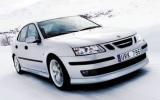I have a theory that a car always performs best on its home ground. The roads on which it was developed and which the company engineers use every day will always give the most flattering impression of a car’s abilities.
So where better for Saab to show off its new 250bhp V6-powered flagship 9-3 than on the roads around its Trollhattan HQ? Indeed, the steely grey eminence of the Saab factory seemed to be permanently on the horizon (which may have said more about the lamentably short test route than the size of the factory).
Although it generally prefers to use turbocharged four-cylinder engines, Saab does have a record of using V6 engines from parent company General Motors. Both the 900 and 9000 had the option of a V6 motor, and early in the life of the 9-5, a highly unusual ‘asymmetrically turbocharged’ V6 was on the options list (which is where it stayed).
Saab’s determinedly independent attitude meant that the current 9-3 wasn’t offered with the V6 engine, relying instead on its famously punchy four-cylinder units. You get the feeling that Saab would have been happy to continue to tweak its core engines had it not been for overwhelming market demands.
Saab engineers say that six-cylinder engines make up just 20 per cent of the European market for medium-size luxury cars like the 9-3. In the US, however, the ‘entry luxury’ market is dominated by the demand for six-cylinder engines. And with the transatlantic market so important, a big motor is vital.
The new engine
The 2.8-litre turbo unit is based on GM’s new ‘global’ V6 architecture, which will also be the basis for next-generation V6 Opel and Alfa Romeo engines. Although much of the development work was carried out by Holden in Australia, Saab says it was closely involved during the ‘conceptual design and development’, mainly because Saab is GM’s centre of excellence for turbocharging.
The all-aluminium 24-valve V6 powerplant has four chain-driven camshafts, the inlet camshaft getting electronically controlled variable valve timing. Saab says the cylinder heads are unique to its version of the V6. Also unique are the pistons (which are cooled from underneath by jets of oil) and the sintered steel conrods.It gets a high-tech manifold, too. Double skinned and hydroformed (bent into shape by massive water pressure) with stainless steel liners, it is said to help reduce cold-start emissions.
But most distinctive of all is the turbocharger’s installation. A single, twin-scroll water-cooled Mitsubishi unit, it is mounted on the right of the engine above the transmission. Two separate inlet tracts feed it, one from each bank of cylinders. As the exhaust gas pulses alternate between each cylinder bank, the turbo’s twin scrolls get alternating blasts of exhaust gas.
Saab is also very proud of writing its own software for the engine management system, which can limit the engine’s torque output in slippery conditions. That’s useful, because there’s masses of torque. The engine ticks over at 720rpm and by 1500rpm 90 per cent of the twist action is already being delivered. By 2000rpm, the full 258lb ft is on tap, and it is available right around the rev counter until 4500rpm.
Performance













Add your comment